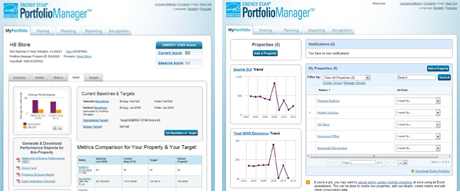As a building manager, you are always looking for ways to improve the efficiency of your property and save money. One way to do this is with the ENERGY STAR Benchmarking Portfolio Manager.
The Benchmarking Portfolio Manager allows you to compare your building’s energy use against similar buildings across the country, so you can see where improvements can be made.
Additionally, the Portfolio Manager can help qualify your property for ENERGY STAR certification, which comes with many benefits like lower insurance rates and utility bills.
Getting started with Benchmarking Portfolio Manager is easy – read on to learn more!
Table of Contents
What is Benchmarking Portfolio Manager?
The Benchmarking Portfolio Manager (BPM) is a tool that can help you assess your building’s energy performance. The BPM can help you track your building’s energy use over time, and compare your building’s energy performance to similar buildings.
The BPM can also help you identify opportunities to improve your building’s energy performance.
There are several reasons why it is important to compare your building’s energy performance against similar buildings.
First, it allows you to identify areas where your building is performing well and areas where there is room for improvement.
Second, it allows you to see how your building’s energy performance compares to other buildings in your area or region. This can help determine whether your building is performing as well as it should be.
Finally, benchmarking can help you identify best practices that you can implement in your own building to improve energy efficiency.
Benefits of ENERGY STAR Portfolio Manager for Businesses
There are many benefits of using ENERGY STAR Portfolio Manager for businesses.
- Save money on energy costs.
- Track progress in reducing energy consumption.
- Compare performance to similar businesses.
- Earn the ENERGY STAR label, which signifies superior energy performance, to attract customers and tenants.
What is ENERGY STAR®?
The Environmental Protection Agency (EPA) and the Department of Energy (DoE) run an energy efficiency program called ENERGY STAR. Established in 1992, ENERGY STAR was created to promote the economic and environmental benefits of energy efficiency.
The Energy Star Performance Score uses your utility bill information to measure how efficiently your buildings use energy. This score is then compared to the average score of other similar buildings in your portfolio.
Depending on a building’s use, the rating system for energy efficiency is on a scale from 0 to 100.
ENERGY STAR Certification
For a business or organization, getting certified by ENERGY STAR means that your facility is recognized as being among the most energy-efficient in the nation.
For consumers, it means that products and services with the ENERGY STAR label are, on average, 10 to 15 percent more efficient than similar models without the label.
Back in 1992, ENERGY STAR started as a voluntary labeling program to identify and promote energy-efficient products and practices.
In 1995, the program expanded to include commercial and industrial buildings, and today, nearly 30,000 commercial buildings and industrial plants have earned the ENERGY STAR label.
To become ENERGY STAR certified, a business or organization first needs to benchmark the energy performance of their facility using the ENERGY STAR Portfolio Manager tool. This tool is free and easy to use, and it allows users to track and compare energy use, water use, waste generation, and more.
Once the energy performance of the facility has been benchmarked, those that have earned a rating of 75 or greater from ENERGY STAR are eligible for certification.
To earn the ENERGY STAR label, businesses and organizations must undergo a verification process, which includes an onsite inspection to confirm that the property meets qualification criteria.
Once the verification process is complete, the business or organization will receive an ENERGY STAR certificate to display at their facility.
The ENERGY STAR certification process is voluntary, but the benefits of becoming certified are numerous.
In addition to the positive environmental impact of becoming more energy-efficient, businesses and organizations that are ENERGY STAR certified can enjoy increased marketing and public relations opportunities, as well as potential cost savings from lower energy bills.
If you’re interested in learning more about the ENERGY STAR certification process, or if you want to find out if your facility is eligible, visit the ENERGY STAR website or contact a qualified professional engineer.

(Source)
ENERGY STAR Benchmarking
Organizations that want to improve their energy efficiency can use the ENERGY STAR® program to benchmark their buildings. This allows them to compare their building’s energy performance to others in their portfolio or similar buildings nationwide.
Partner with an energy management service provider to transfer data from your portfolio to the ENERGY STAR Portfolio Manager® and keep track of your progress while protecting data integrity.
We offer three ENERGY STAR services to support your energy efficiency initiatives: ENERGY STAR Benchmarking, ENERGY STAR Certification, and Regulatory Reporting.
ENERGY STAR Regulatory Reporting
Some localities have enacted laws requiring all buildings to report their annual energy consumption and water usage. New York City was the first to do it in 2010, and since then many have followed including Seattle, Austin, San Francisco, Minneapolis, Washington D.C., Boston, Chicago, and Philadelphia. These cities are now requiring or will soon require ENERGY STAR benchmarking and reporting.
But these requirements vary by city and only apply to buildings that meet them.
We can support the reporting requirements of multi-tenant companies by transferring their portfolios to Energy Star’s Portfolio Manager. This eliminates the hassle of manually entering data into the software and protects the integrity of their data.
For commercial real estate properties that rent to businesses, we can handle the collection of data and the reporting to landlords.
Regulatory reporting also enables benchmarking to bring visibility into site performance. This visibility allows companies to hone in on certain sites that may need improvement or that could benefit from some best practices.
Conclusion
ENERGY STAR Benchmarking Portfolio Manager is a great way to benchmark your building’s energy performance, compare it against similar properties, and identify potential areas for improvement.
Additionally, certification through ENERGY STAR can help lower your insurance rates and utility bills.
The ENERGY STAR benchmarking tool provides a 1-100 ENERGY STAR score for buildings which indicates how efficiently a building uses energy compared to similar buildings. It can help identify opportunities for energy efficiency improvements and track progress over time.
Getting started with benchmarking in Portfolio Manager is easy – start now!





